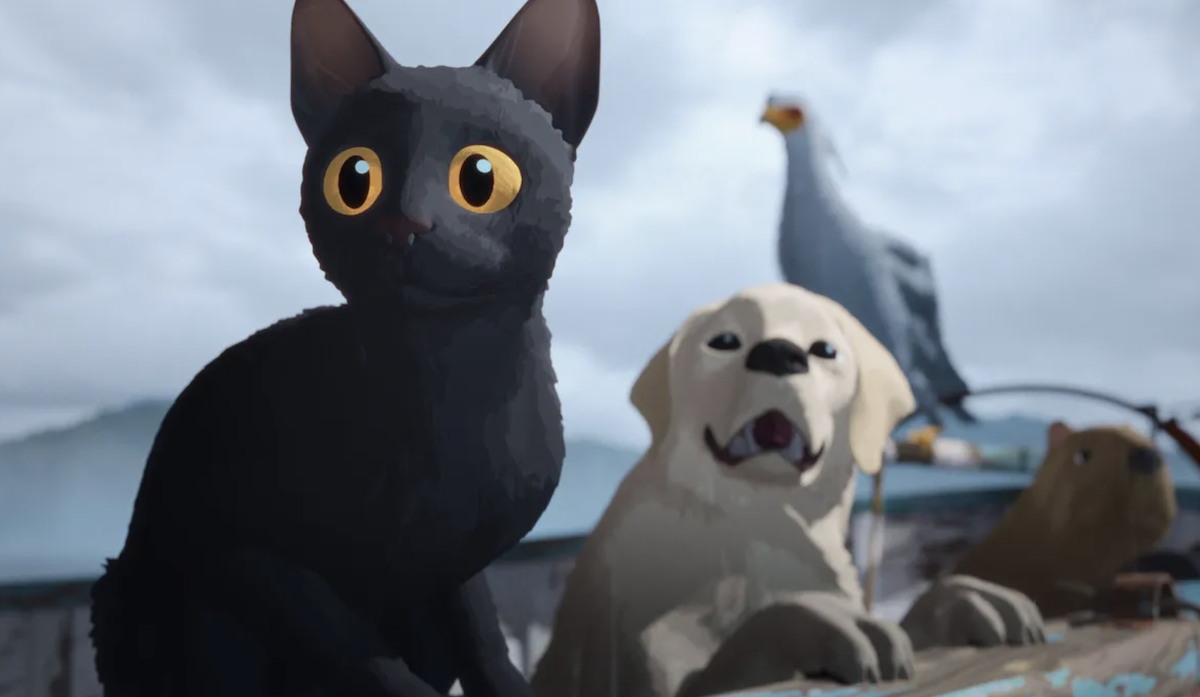‘Flow’ Review: A Cute Kitty Centers One of the Most Groundbreaking Animated Films About Nature Since ‘Bambi’


There’s a moment near the end of Latvian animation director Gints Zilbalodis’ “Flow” that powerfully tugs at the heartstrings. It’s when the film’s central character, a black cat who you’ve come to have a profound emotional connection with, rediscovers a lost ball that he and his animal friends (especially a lemur) had been playing with earlier in the movie. He thought he’d never see it again. And suddenly he does.
Sometimes, lost things can be found again.
More from IndieWire
Oscar Nominee Tony Curtis Battles an Evil Boil in Bonkers 'The Manitou'
Jane Schoenbrun Talks Future Plans on A24 Podcast: 'I Want to Make a Stoner Comedy for Reals'
If you thought that emotion elicited without cloying manipulation was something lost in animation, it is found again in “Flow” as well. A movie brimming with sentiment but not sentimentality, this is one of the most moving animated films in recent memory, and, beyond that, groundbreaking too. The anthropomorphic animal characters of 21st century U.S. animated features have nothing on the animal stars of “Flow,” who never utter a word and act as nothing more than animals. That’s enough.
Building on the extraordinary naturalism that Disney pioneered for its animal characters in the early 1940s, particularly with Figaro the cat in “Pinocchio,” as well as “Bambi” — built out of the closest study, rather than outright rotoscoping — Zilbalodis lets his animals be animals. The cat, who’s the lead character in “Flow,” conveys the world through the way he arches his back, crouches to the ground, perks up or flattens his ears, and widens his eyes in this completely dialogue-free movie about the wonder of perception and the underappreciated latent intelligence of animals.
When the film opens, the cat is living in a house where there are no humans present, though there are signs that human life was very recently there. There’s an artist’s desk in the loft where the kitty likes to curl up, and a sketch of him that someone’s made. And around the house, located in a beautiful forest, are statues of the cat — one that’s incredibly gianted-size among them. This cat was clearly loved. But now he’s alone.
What caused the disappearance of humanity in “Flow” is never explained, and not even human remains are seen (which makes sense for a movie that, in every respect, can and should be enjoyed by kids the world over). It’s like this extinction event was a vanishing, and to be fair, one animal later in the movie almost does seem to be raptured, pulled up into the heavens in one of the movie’s most transcendent moments.
Maybe the animals have inherited the earth. But first, and just as Biblical, there’s another great flood that spreads over everything. Even the giant cat statue is completely covered by the waves, except for the tiniest tip of one of its ears that our cat hero stands atop until a boat drifts past. On that boat is a capybara, who he bonds with. And later a lemur, a stork, and a golden retriever.
Well, “bonds with” may be a stretch. Zilbalodis, just 29 years old and the director of the acclaimed 2019 animated feature “Away,” finds fleeting moments of connection for the cat with his fellow voyagers but also shows him always finding ways to keep his distance. As cute as this cat is, it’s not from underscoring his cuddliness. Cat lovers, of course, revere feline expressionlessness, but a wellspring of expression still does manage to come from the cat even without the animators, based in France and Belgium as well as Zilbalodis’ native Latvia, drawing human-style emotions on his face.
The boat — the smallest scale ark imaginable, if we really are going Biblical here — drifts through remnants of human civilization peeking through the surface of the water as our animals passively witness it all. They do learn how to steer the rudder on the boat, stretching the plausibility of this scenario a tad, but, really, what follows is just the animals hanging out together in quiet cohabitation until various things happen to them. The cat is knocked into the water several times, but always manages his way back — not before taking in the beauty of the brightly colored fish beneath, who he brings back to create a small pile of good eatin’ for himself back onboard.
Walt Disney’s “Bambi” is considered by animation buffs to be a high point in the history of the medium: For the depth created by its multi-plane camera, the almost nature-doc-like naturalism of its animal characters’ movements, the environmental effects of the rain, snow, forest fire, and leaves blowing throughout that add texture, and its almost plotless “circle of life” theme and structure. “Flow” matches that and ups the ante — these animals don’t even talk! The environments are CGI and the “camera” moves through them with a handheld-like jerkiness and momentum that puts to shame Jon Favreau’s idea of simulating “filming” an animated movie in his “Lion King” remake. You really feel like you’re watching a lived-in environment here, with the frame that’s limiting what you’re seeing capable of going in any number of directions.
But for the animals in “Flow” themselves, Zilbalodis made a powerful choice: They’re obviously built around CGI wireframe models, but their surface texture — their fur — is abstracted to look like hand-drawn animation. It distances the cat and all the other members of the menagerie from anything resembling photorealism, instead having them bear the human-made warmth that hand-drawn conveys like nothing else. Maybe it’s just because Zilbalodis and his teams didn’t have the budget to animate rippling follicles of fur. But if so, it’s an example of a limitation inspiring an even greater artistic choice. The surface may not be entirely real, but the movements modeled underneath are so lifelike you feel like you’re glimpsing Plato’s eternal forms: The everlasting underneath a transitory surface.
The closest thing to “Flow” in recent memory is 2002’s “Spirit: Stallion of the Cimarron,” which also opted not to anthropomorphize its animal characters and could have been, for all intents and purposes, a “silent” film as well if not for the choice to have Matt Damon represent the title character as the film’s narrator. Or maybe Suzie Templeton’s stop-motion “Peter and the Wolf” short from 2006. Which is all to note what a rarity and a wonder “Flow” really is. It’s not just a supreme example of a movie kids will love that adults will too. With its wordlessness, this is a film that could play in any country of the world, its capacity to reach literally everyone limitless. And yet it’s radical while being as accessible as any animated film could ever be. By any standard, “Flow” should be a triumph of commerce as well as art.
Will that happen? In any world that made sense, sure. But our reality is a different thing. If somehow it is a smash, then the film’s own touching moment of rediscovery will be echoed in real life: Lost things really can be found again.
Grade: A
“Flow” premiered in Un Certain Regard at the 2024 Cannes Film Festival. Sideshow and Janus Films will release it in the U.S.
Best of IndieWire
Sign up for Indiewire's Newsletter. For the latest news, follow us on Facebook, Twitter, and Instagram.

